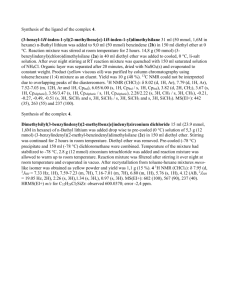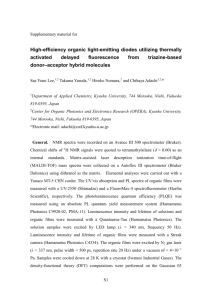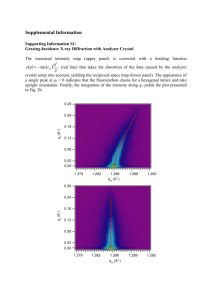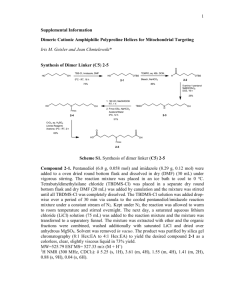Table 1 - Royal Society of Chemistry
advertisement
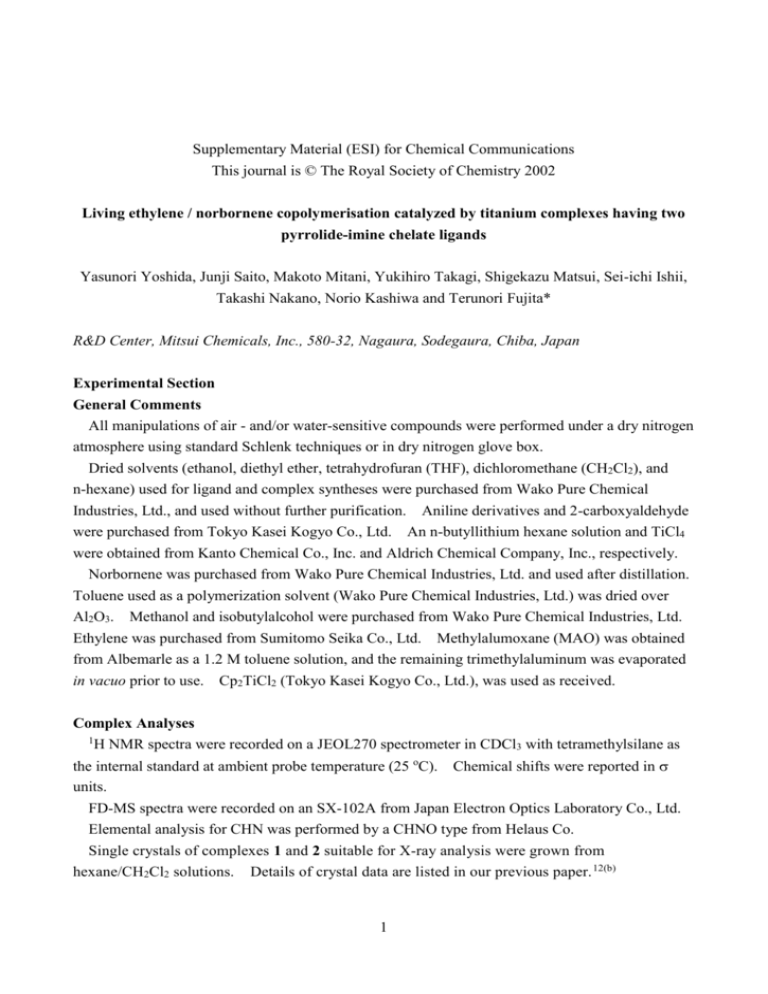
Supplementary Material (ESI) for Chemical Communications This journal is © The Royal Society of Chemistry 2002 Living ethylene / norbornene copolymerisation catalyzed by titanium complexes having two pyrrolide-imine chelate ligands Yasunori Yoshida, Junji Saito, Makoto Mitani, Yukihiro Takagi, Shigekazu Matsui, Sei-ichi Ishii, Takashi Nakano, Norio Kashiwa and Terunori Fujita* R&D Center, Mitsui Chemicals, Inc., 580-32, Nagaura, Sodegaura, Chiba, Japan Experimental Section General Comments All manipulations of air - and/or water-sensitive compounds were performed under a dry nitrogen atmosphere using standard Schlenk techniques or in dry nitrogen glove box. Dried solvents (ethanol, diethyl ether, tetrahydrofuran (THF), dichloromethane (CH2Cl2), and n-hexane) used for ligand and complex syntheses were purchased from Wako Pure Chemical Industries, Ltd., and used without further purification. Aniline derivatives and 2-carboxyaldehyde were purchased from Tokyo Kasei Kogyo Co., Ltd. An n-butyllithium hexane solution and TiCl4 were obtained from Kanto Chemical Co., Inc. and Aldrich Chemical Company, Inc., respectively. Norbornene was purchased from Wako Pure Chemical Industries, Ltd. and used after distillation. Toluene used as a polymerization solvent (Wako Pure Chemical Industries, Ltd.) was dried over Al2O3. Methanol and isobutylalcohol were purchased from Wako Pure Chemical Industries, Ltd. Ethylene was purchased from Sumitomo Seika Co., Ltd. Methylalumoxane (MAO) was obtained from Albemarle as a 1.2 M toluene solution, and the remaining trimethylaluminum was evaporated in vacuo prior to use. Cp2TiCl2 (Tokyo Kasei Kogyo Co., Ltd.), was used as received. Complex Analyses 1 H NMR spectra were recorded on a JEOL270 spectrometer in CDCl3 with tetramethylsilane as the internal standard at ambient probe temperature (25 oC). Chemical shifts were reported in units. FD-MS spectra were recorded on an SX-102A from Japan Electron Optics Laboratory Co., Ltd. Elemental analysis for CHN was performed by a CHNO type from Helaus Co. Single crystals of complexes 1 and 2 suitable for X-ray analysis were grown from hexane/CH2Cl2 solutions. Details of crystal data are listed in our previous paper. 12(b) 1 Data collection for complex 1 was made on a Rigaku AFC7R diffractometer with graphite monochlomated Mo-K radiation at 296K. The data were corrected for Lorentz and polarization effects, but no decay collection was applied. The structure was solved by direct methods (SIR92) and expanded using Fourier techniques (DIRDIF94). The non-hydrogen atoms were refined anisotropically. Hydrogen atoms were refined isotropically. Data collection for complex 2 was made on a Rigaku RAXIS-IV Imaging Plate diffractometer with graphite monochlomated Mo-K radiation at 150K. The data were corrected for Lorentz and polarization effects, but no decay collection was applied. The structure was solved by heavy-atom Patterson methods (PATTY) and expanded using Fourier techniques (DIRDIF94). The non-hydrogen atoms were refined anisotropically. Hydrogen atoms were included but not refined. All calculations were performed using the teXsan crystallographic software package of Molecular Structure Corporation. Polymer analyses The 13C NMR spectra were obtained using a JEOL GSX 270 spectrometer operating at 67.9 MHz (13C) direct observation, in the PFT mode at 110oC. Copolymer samples were dissolved in C2D2Cl4 solvent. A 90o pulse of 8.6 s was employed with a repetition of 21 s. A window of 18350 Hz was observed, typically accumulating from 800 to 1200 free induction decays on 64K of computer memory. CPD (composite pulse decoupling ) was used to remove 13 C-1H couplings. Chemical shifts were reported in units. GPC analysis for ethylene / norbonene copolymer: Molecular weight distribution (Mw/Mn) value of polyethylene was determined using a Waters 150-C gel permeation chromatograph at 145 oC using polystyrene calibration (or polyethylene calibration for polyethylene analysis) and equipped with three TSKgel columins (two sets of TSKgelGMHHR-H(S)HT and TSKgelGMH6-HTL). o-Dichlorobenzene was employed as a solvent at a flow rate of 1.0 mL/min. Glass transition temperatures (Tg) of the copolymers were determined by DSC with a Shimadzu DSC-60 differential scanning calorimeter, measured upon reheating the polymer sample to 250 oC at a heating rate of 20 oC / min. Synthetic procedures for complexes 1 and 2 2-(Ph-NCH)C4H3NH (1a: ligand for complex 1) To a stirred solution of pyrrole-2-carboxyaldehyde (5.07 g, 53.3 mmol) in dried ethanol (150 mL), aniline (4.96 g, 53.3 mmol) and formic acid (1 mL), as a catalyst, were added. The reaction mixture was stirred for 72 h at rt. Evaporation of the ethanol gave a solid residue, which was purified by column chromatography on silica gel using hexane/ethyl acetate (9/1) as eluent to afford 2 a flesh-colored solid. Recrystallization from n-hexane gave 1 as a flesh-colored powder in 65% yield (5.98 g, 35.2 mmol). H NMR (270 MHz, CDCl3, : 6.30 (dd, J = 2 Hz, 1H, pyrrole ring aromatic-H), 6.69 (d, J = 2 Hz, 1H, pyrrole ring aromatic-H), 6.89 (d, J = 2 Hz, 1H, pyrrole ring aromatic-H), 7.1-7.5 (m, 5H, benzene ring aromatic-H), 8.29 (s, 1H, –CH=N–), 9.85 (br s, 1H, pyrrole ring NH). FD-mass: m/z: 170. Anal. Calcd for C11H10N2: C, 77.62; H, 5.92; N, 16.46. Found: C, 77.73; H, 5.84; N, 16.33. 1 [2-(Ph-NCH)C4H3N]2TiCl2 (1) To a stirred solution of 1a (1.035 g, 6.08 mmol) in dried diethyl ether (15.5 mL) at -78 oC, a 1.54 M n-butyllithium hexane solution (4.15 mL, 6.38 mmol) was added dropwise over a 5 min period. The mixture was allowed to warm to room temperature and stirred for 4 h. The resulting mixture was added dropwise over a 30 min period to a 0.5 M n-heptane solution of TiCl4 (6.08 mL, 3.04 mmol) in dried diethyl ether (15.5 mL) at -78 oC with stirring. The mixture was allowed to warm to rt and stirred for 12 h. Then, the reaction mixture was filtered through a glass filter, and the filtrate was concentrated in vacuo to give a solid. Dried diethyl ether (20 mL) was added to the solid, and the mixture was stirred for 10 min and filtered. The filtrate was concentrated in vacuo to yield a black solid. CH2Cl2 (5 mL), and n-hexane (10 mL) were added to the solid and the mixture stirred for 1 h and then filtered. Evaporation of the solvent gave 1 (1.10g, 2.40 mmol) as a black solid in 79% yield. H NMR (270 MHz, CDCl3, : 6.0-7.9 (m, 6H, pyrrole ring aromatic-H + 10H, benzene ring aromatic-H), 7.80 (s, 2H, –CH=N–). FD-mass: m/z: 456 (M+). Anal. Calcd for C22H18N4TiCl2: C, 57.80; H, 3.97; N, 12.25. Found: C, 58.29; H, 3.95; N, 12.62. 1 2-(cyclohexyl-NCH)C4H3NH (2a: ligand for complex 2) To a stirred solution of pyrrole-2-carboxyaldehyde (5.0 g, 52.6 mmol) in dried ethanol (150 mL), a cyclohexylamine solution in methanol (5.22 g, 52.6 mmol) was added. The mixture was stirred for 12 h at rt. The resulting mixture was concentrated in vacuo to yield 2a (8.88 g, 50.4 mmol) as a brown oil in 96% yield. H NMR (270 MHz, CDCl3, : 1.1-1.9 (m, 10H, cyclohexyl-H), 3.0-3.2 (m, 1H, cyclohexyl-H), 6.21 (dd, J = 2 Hz, 1H, aromatic-H), 6.48 (d, J = 2 Hz, 1H, aromatic-H), 6.89 (d, J = 2 Hz, 1H, aromatic-H), 8.13 (s, 1H, –CH=N–), 8.35 (br s, 1H, pyrrole ring-NH). FD-mass: m/z: 176. Anal. Calcd for C11H16N2: C, 74.96; H, 9.15; N, 15.89. Found: C, 74.54; H, 9.31; N, 15.93. 1 [2-(cyclohexyl-NCH)C4H3N]2TiCl2 (2) To a stirred solution of 2a (1.02 g, 5.78 mmol) in dried diethyl ether (25 mL) at -78 oC, a 1.54 M n-butyllithium hexane solution (3.8 mL, 6.08 mmol) was added dropwise over a 5 min period. 3 The mixture was allowed to warm to room temperature and stirred for 4 h. The resulting mixture was added dropwise over a 30 min period to a 0.5 M n-heptane solution of TiCl4 (5.78 mL, 2.89 mmol) in dried diethyl ether (25 mL) at -78 oC with stirring. The mixture was allowed to warm to room temperature and stirred for 16 h. The resulting mixture was concentrated in vacuo to afford a black solid. Dried diethyl ether (20 mL) was added to the solid, and the mixture was stirred for 10 min and filtrated. The filtrate was concentrated in vacuo to yield a black solid. CH2Cl2 (30 mL) was added to the solid and the mixture stirred for 1 h and then filtered. Evaporation of the solvent gave 2 (0.52 g, 1.11 mmol) as a black solid, in 38% yield. H NMR (270 MHz, CDCl3, : 0.7-2.7 (m, 22H, cyclohexyl-H), 6.28 (dd, J = 2 Hz, 2H, aromatic-H), 6.60 (d, J = 2 Hz, 2H, aromatic-H), 7.80 (d, J = 2 Hz, 2H, aromatic-H), 8.00 (s, 2H, –CH=N–). FD-mass: m/z: 468 (M+). Anal. Calcd for C22H30N4TiCl2: C, 56.31; H, 6.44; N, 11.94. Found: C, 56.79; H, 6.71; N, 12.12. 1 Polymerisation Ethylene / NB copolymerisation was performed in a glass flask (500 mL) equipped with a mechanical stirrer, a temperature probe, and a condenser. Toluene (250 mL) was introduced to the nitrogen-purged reactor and stirred 600 rpm. The solvent was kept at the prescribed polymerisation temperature, and then prescribed NB was charged into the reactor. Then the ethylene gas feed (100 L/h) was started. After 10 min, polymerisation was initiated by the addition of 1.25 M solution of MAO in toluene (1 mL, 1.25 mmol) and then a 0.002 M solution of a complex in toluene (0.5 mL, 1 mol) into the reactor. The polymerisation was quenched after the prescribed time by the addition of isobutylalcohol (5 mL). The resulting mixture was added to the acidic methanol (1000 mL including 5 mL of conc. HCl). The copolymer was collected by filtration, washed with methanol, and then dried at 130 oC in vacuo for 10 h. 4 28.777 28.424 28.382 28.094 31.065 40.041 39.531 45.257 45.809 PPM 50 45 40 35 30 13 25 C NMR spectrum for ethylene / NB copolymer prepared by complex 1 / MAO (entry 1) 5 28.778 28.374 28.086 31.061 40.054 39.560 45.280 45.849 PPM 50 45 40 35 30 13 25 C NMR spectrum for ethylene / NB copolymer prepared by complex 2 / MAO (entry 2) 6

